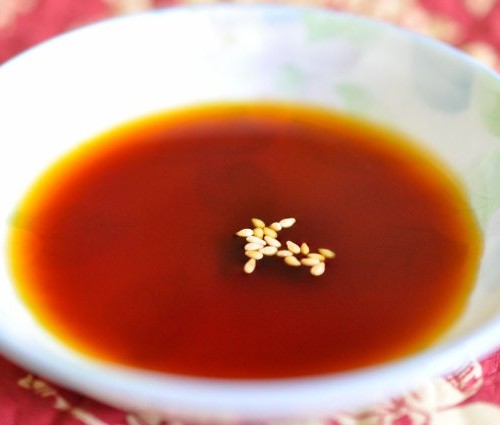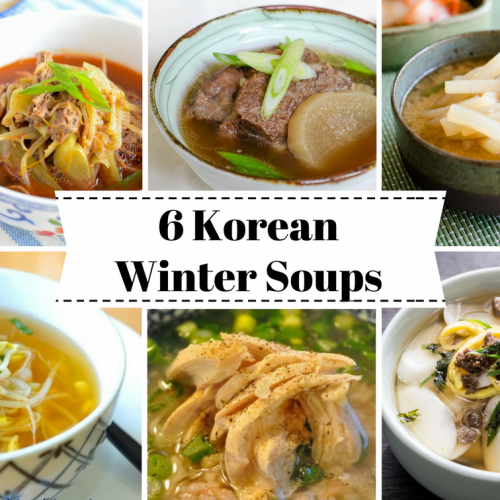
Korean Seasoning Sauces (Yangyeom Jang or Yangnyum Jang)
In my attempt to categorize/analyze Korean sauces, I have divided the sauces into 2 groups: Korean Dipping Sauces and Korean Seasoning Sauces. I have searched high and low for some reference site or book that organizes Korean sauces in some structured way. No such luck. So, here’s my attempt – to me the most natural way of categorizing the sauces is to base it on what the main ingredient is.
In terms of the main ingredient, classic Korean sauces are based on one of the 4 ingredients: soy sauce, dwenjang (soybean paste), gochujang (red chili bean paste) and gochukaroo (red chili pepper powder). Often it is a mixture of one or more of these but usually one ingredient takes center stage.
Soy Sauce based sauces –
- Yangnyum/Yangnyeom Jang(양념장) (or Yangnyum Kanjang) is used for the following dishes: (*BTW, the list below is by no means complete, so if you can think of any other dishes, please let me know!)
- Mungbean jelly (청포묵 Cheongpo mook), Acorn jelly(도토리묵 Dotori mook)
- Soybean sprout rice (콩나물밥 Kongnamul bap)
- Sauce for dressing fresh vegetables (야채무침 Yache moochim), 오이무침 Oi Muchim
- Plain Raw or Pan fried Tofu (두부 Dooboo), Raw Soft Tofu (순두부 Soondooboo)
- Sauce for steamed clams (꼬막장 kkomakjang)
- Chokanjang(초간장) is used for the following dishes:
- Zucchini Fritters (호박전 Hobak Jeon), Crispy Zucchini Pancakes (호박부침개 Hobak Buchimgae), Potato Pancakes (감자전 Gamjajeon)
- Steamed or Fried Dumplings (만두 Mandoo)
- Boiled beef slices (편육 Pyeonyook)
- Vegetable Fries (야채튀김 Yache Twikim
- Jorimjang(조림장) is used for the following dishes:
- Braising Fish (생선조림Saengsun jorim) such as mackerel, sardines, sea bass, cod, etc.
- Jangjorim (장조림)
- Potato Jorim (감자조림 Kamja jorim)
- Bulgogi/Kalbi Yangnyeom (불고기/갈비 양념)
- Tofu jorim (두부조림 Dooboo jorim)
As it turns out, I have already posted many of the recipes above. And other than the Bulgogi sauce, Yangnyum Jang is the most complicated and has the most number of variations depending on the dish.

So I am going to further categorize the yangnyum jang (Korean seasoning sauces) based on its flavor profile as follows:
- Basic Korean salty and spicy seasoning sauce (yangnyum jang)
- 3 Tbs soy sauce
- 1 Tbs water or anchovy stock
- 2 tsp or less gochukaroo (Korean red chili pepper powder)
- 1 ½ tsp ~ 2 tsp sesasme seeds
- ½ ~ 1 tsp sugar
- Tangy Korean seasoning sauce (yangnyum jang)
Great for fishes, fried foods, or anytime you want a light, tangy sauce without the nutty, rich flavor of sesame oil.
-
- Basic yangnyeom jang
- 1 Tbs rice vinegar or lemon juice
- Nutty Korean seasoning sauce (yangnyum jang)
Great for fresh tofu, rice with soybean sprouts (콩나물밥 kongnamul bap), stone pot rice (돌솥밥 dolsot bap) or mungbean jelly(청포묵 cheongpo mook)/acorn jelly(도토리묵 dotori mook).
-
- Basic yangnyum jang
- 1 T sesame oil
* A classically trained Korean chef will tell you that vinegar and sesame oil should not be added together. It is either one or the other. It’s because the vinegar and oil kind of negate each other, but just like how salad dressings work, it can actually taste great even if you add both – bringing you all the flavors of sweet, salty, sour, spicy and nutty!
- Kitchen sink Korean seasoning sauce (yangnyum jang)
Great for dressing fresh vegetables such as romaine or green lettuce, napa/regular cabbage (배추 baechoo) or Korean chives (boochoo 부추).
-
- Basic yangnyum jang
- 1 T rice vinegar/lemon juice
- 1 T sesame oil
- 1~2 tsp sugar (to balance the stronger sour and nutty taste)
- 1 T chopped green onion
- 1 tsp chopped fresh garlic (optional)
- 1 tsp chopped fresh green chili peppers (optional)
Unlike salads – I hate eating salads that are not freshly tossed..- I like to let the vegetables sit for a couple minutes in the sauce (especially for strong crisp vegetables like chives, cabbage) so it soaks up the flavor. These vegetables taste great with grilled meats like bulgogi, kalbi or pork belly, so try it next time you have a BBQ party!
Storage
- Make a batch and store in the fridge for days up to 2 weeks. If you omit perishable ingredients like green onions/garlic, you can store it even longer.
Variations
- Make a lighter (less salty) sauce by adding 1 Tbs water or 1 Tbs anchovy stock. Goes great as sauce for Jeon and Vegetable fries or with foods that already have enough salt.
Finally, if you are wondering about how to make the Acorn Jelly (Dotori mook) dish, here’s what I did –
- Prepare the Kitchen Sink Yangnyum Jang with green onions.
- Cut the Acorn Jelly into chunky strips. Don’t cut too thin because they break easily when picked up. Plate the jelly pieces.
- Wash, cut few stems of the Korean minari(미나리) or water dropwort. Add the minari on top of the jelly. If you can’t get minari, substitute julienned cucumbers or any kind of lettuce.
- Dress the jelly and minari with the Yangnyum jang. 2-3 Tbs of the sauce should be good for handful of jelly.
- Sprinkle the top with some toasted sesame seeds and roasted laver (김 Kim) strips.
- ** All the ingredients (3,4,5) other than the jelly and the sauce are optional.
Enjoy!!



















Love these recipes
Yay!! Thank you, so happy to hear it. Enjoy!